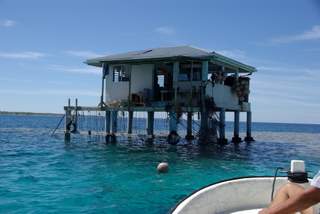Makemo à Fakarava 7 avril 16° 18.3'S 144°21.2'W

Canopus 3 on the Blue Water Rally
Jean Michel Coulon
Tue 8 Apr 2008 11:29
|
The visit to the pearl farm this morning (7 April)
was much more interesting than I had expected. Called Teanuanua Beach
Pearls, the farm is part of a family-owned mini-conglomerate that includes the
only Makemo pension mentioned (for excellent food) in my guidebook and, back in
the village, a grocery and hardware store along with several studio apartments
still nearing completion that are intended for tourists. The farm and
pension are located near the other pass (Tapuhiria) into the lagoon, the pension
along a lovely beach and the farm perhaps half a mile out into the lagoon.
To get there Jean-Michel and Michel had arranged transport with co-owner and, as
we eventually concluded, primary driving force Nadia Muller, who, as you
doubtless have guessed from her name, is not only the wife of Jean-Claude Muller
but a tatooed Polynesian whose features suggest some Chinese
ancestry. Our instructions were to meet at 0930 at the market near the
boulangerie, and among the first indications that we were not dealing with
typical laid-back locals was the punctuality of our hosts--as we walked into the
market's dirt parking area Jean-Claude hustled over from the adjacent house,
introduced himself, and off we went, with a brief stop at the airport to pick up
newspapers (the atoll receives four flights per week from Papeete).
Jean-Claude, incidentally, is impressively tatooed but, judging from his accent,
grew up in metropolitan France.
The farm, a square wooden structure built on pylons
secured to a reef by heavy cables, consists of two rooms (not counting an alcove
where a doorless toilet faces south across the lagoon) some eight feet above sea
level plus a large area facing north built of planks with wide gaps between
them.
 Strings of oysters that have undergone an
impressively precise insertion of a pearl-inducing irritant hang in the water
between the planks--think of it as an aquatic recovery room for the
oysters before they are moved farther out in the lagoon, where they will
(in most cases) eventually produce a marketable pearl. In one of the
two rooms were three work stations and two young workers who turned
out to be the Muller's daughter and son-in-law. His job consisted of
taking one oyster at a time from a bin, inserting a metal clamp to keep the
shell sufficiently open, then inserting what looked like a yellow plastic ball
(the irritant) the size of a BB that actually was made from giant freshwater
mussel shells from the Mississippi River, and finally inserting a tiny slice of
graft tissue cut with surgical precision by the daughter from the coat of a
(probably involuntary) donor oyster. The graft tissue determines the color
of the eventual pearl. When she is not preparing the tissue, the
daughter performs the same tasks as her husband. Another young
man's primary task (in the other room) seemed to be drilling a hole along the
edge of each post-surgery oyster shell near the hinge to facilitate adding the
oyster to a string of its fellows; ideally his job is more varied than
that, but I did not ask. Once back in the
village we were shown a variety of pearls by Nadia, and I must confess to a rare
temptation to buy a particularly beautiful (and expensive) bracelet, but
fortunately for family finances I resisted. After all, I would look silly
in pearls.
We are now motoring to Fakarava--the true wind
strength is a meagre five knots, and it is coming from a very strange direction,
mostly west, while the trades blow from the east, southeast, or northeast.
Fakarava has two passes, and the one on the southeast side we will use to enter
the lagoon is supposed to be superb for snorkeling as well as diving. We
should be there early tomorrow. |